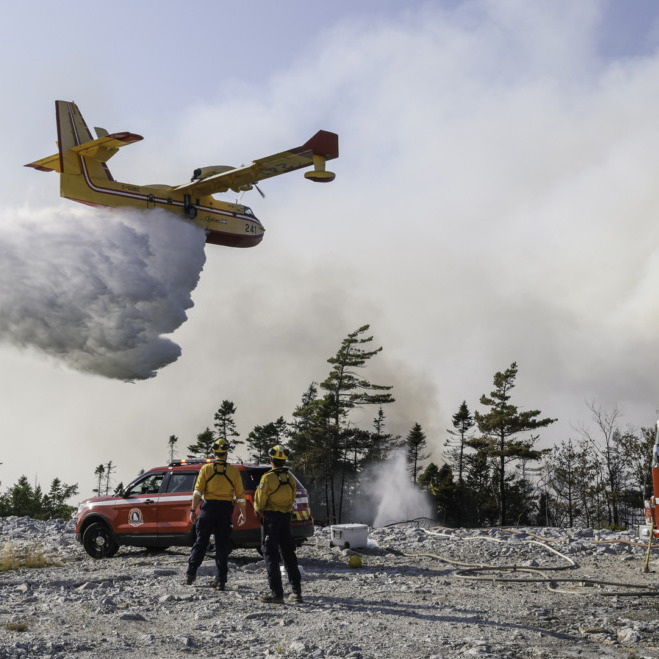
Wildfires continue at home as Annapolis Valley students return to Dalhousie
The Long Lake wildfire has forced the evacuation of over 330 homes
Some Dalhousie University students are returning to classes facing uncertainty at home, as an out-of-control wildfire continues to burn in West Dalhousie, N.S.
The Long Lake wildfire is the most severe of several fires that swept through Nova Scotia this summer, including blazes near Musquodoboit Harbour and Susies Lake.
For Ava Stark, a second-year Dalhousie medical sciences student from Annapolis Royal, N.S., returning to Halifax for classes comes with uncertainty.
“It’s nerve-wracking because my mom, my sister and all of my family are down there, and now I’m not getting as many updates,” says Stark.
The Long Lake wildfire has grown to over 8,000 hectares since it began on Aug. 13, more than doubling in size over the weekend of Aug. 23. New evacuation orders, totalling over 330 homes, are affecting over 1,000 people in Annapolis County.
Nova Scotia Premier Tim Houston confirmed in a statement that 20 homes were destroyed or damaged, along with 11 outbuildings on nearby properties.
Tamami Poirier, a second-year Dalhousie medical sciences student, said she has mixed emotions about leaving her family home in Middleton, N.S., amid the growing number of evacuations.
“I’m a bit relieved because I’ll be away from it all and won’t have to worry, but I’m also worried for my parents,” says Poirier. “I don’t think it’ll spread as far as Middleton, but I’m just worried that if they get evacuated, they’ll have to deal with it on their own.”
Environmental impacts
The province endured drought-like conditions, with little to no rainfall from early June to the end of August. Concerns over the dry conditions and subsequent wildfire risks prompted the provincial government to issue a province-wide burn ban and close all wooded trails, with violators facing fines of up to $25,000.
Environment Canada issued air quality warnings for Annapolis County, along with special air quality statements for Halifax, Lunenburg, Kings and Hants counties. The statements advise vulnerable groups, including people aged 65 and older, young children and individuals with existing medical conditions, to avoid activity outdoors.
Poirier says that at the pharmacy where she works, many people — particularly seniors — have requested face masks to protect themselves from the smoke.
“There are a lot of older people with respiratory diseases who are very worried,” she says.
Stark spent several nights over the past couple of weeks sleeping on the couch because of smoke in her bedroom.
“I accidentally left my window open and woke up to the distinct smell of campfire,” she says. “The room smelled so bad.”
Raphael Chavardes, a wildfire researcher with Natural Resources Canada, said in a statement to the Dalhousie Gazette that students should visit FireSmart Canada for information on evacuations and burning restrictions.
Community responses
While some residents remain concerned about the wildfire’s health effects, Poirier says opinions in her Middleton community are divided over the threat it poses.
“There are people who are scared and constantly checking the news for updates, and there are people who don’t understand the impact and how quickly the fire can spread,” she says. “They’re mostly just thinking it’s not going to affect them.”
County of Annapolis Deputy Warden Dustin Enslow said the community has come together “phenomenally” in the face of difficult circumstances. He called on Nova Scotians to focus on the community’s strength and the support it has received from across the country.
“Our community is resilient, as most Nova Scotians are, so when there’s a need, the community stands up,” says Enslow. “We’ll adapt and overcome, and we’ll get back to normal.”
The wildfire response has been both local and national, drawing on Department of Natural Resources personnel and firefighters from across Atlantic Canada. The Northwest Territories, Manitoba and Quebec also contributed water bombers to the firefighting efforts.
The municipality organized several community events, including dinners, to bring people together and restore a sense of normalcy. He added that student interns at the municipal office have contributed by taking on administrative duties tied to the wildfire response.
“We’re really just trying to focus on positivity and how people are staying positive to work through this difficult time,” Enslow says.






